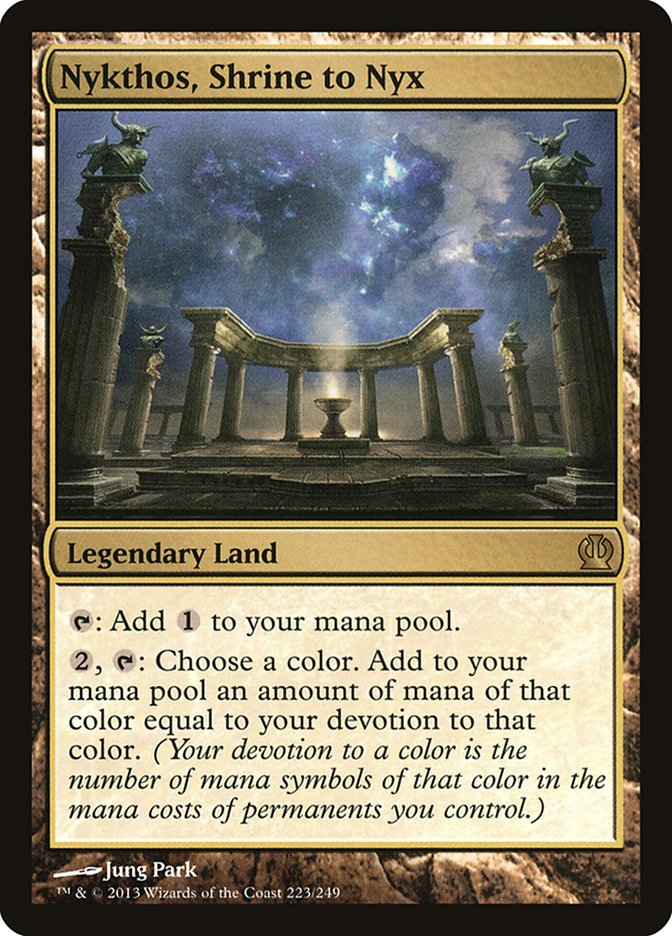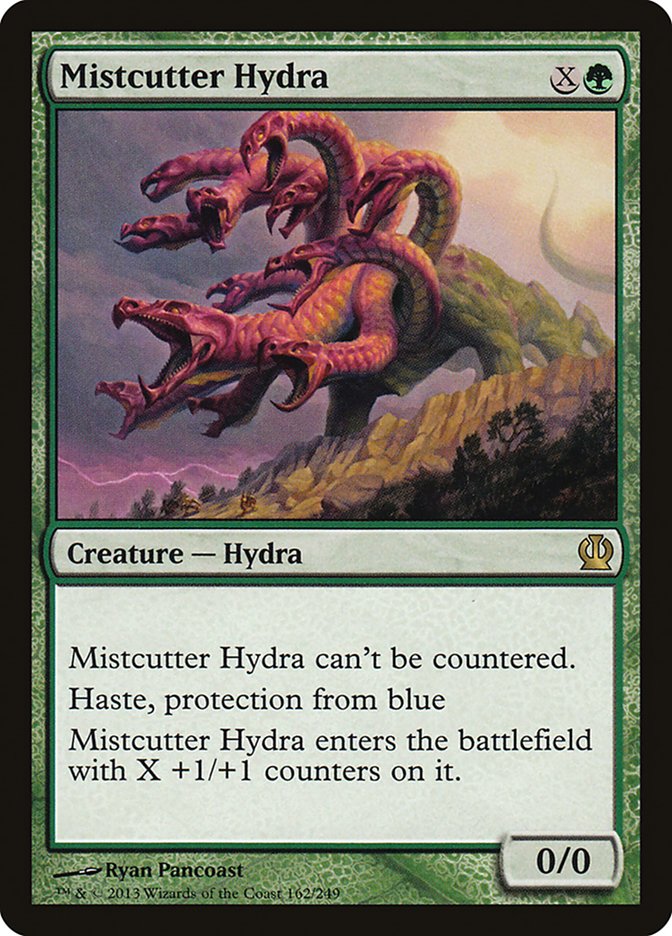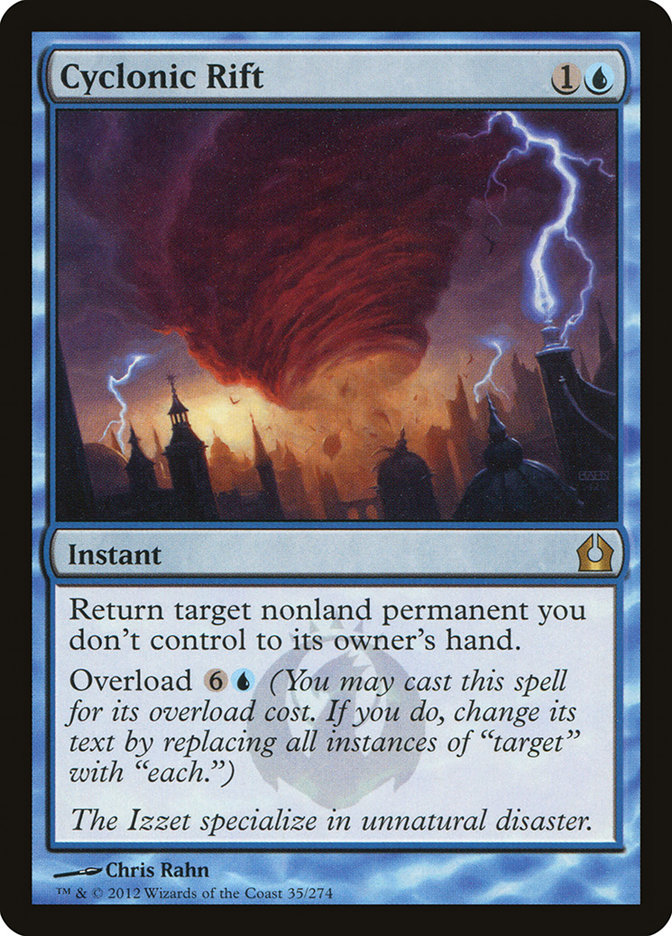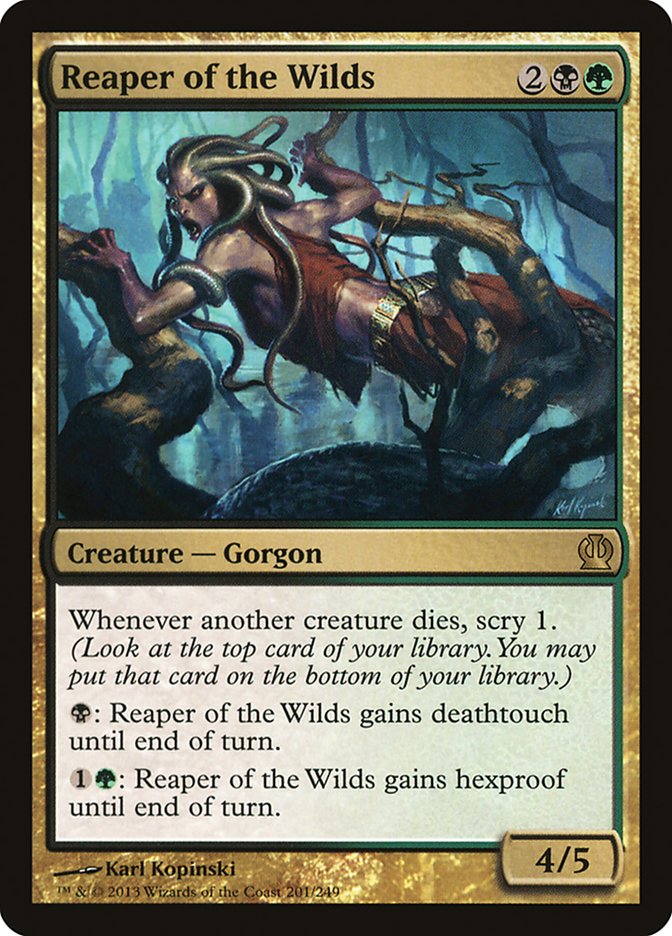Theros Standard so far has been dynamic, interesting, and diverse. The first week of Theros Standard showcased both conservative control decks and steamy Red Decks, which gave way to midrange aggro decks with giant monsters and red-hating white buff spells. The Pro Tour in Dublin opened the door to a variety of Devotion decks, powerhouse decks that took differently-colored paths to the accumulation of particular pips, exploiting both the Theros God cycle and signature land Nykthos, Shrine to Nyx.

The most recent weekend showcased re-ups from not just some of the Devotion decks from the Pro Tour but some of their natural enemies.
As many of these strategies are becoming increasingly intuitive for players who have been paying attention to the Theros Standard metagame, I thought I would do something a bit different this week: namely, talk about some of the details and historical ancestors of these decks… and also some of the cards that we might look to in the future to beat the current crop.
Generally… What’s Next?
Grand Prix Louisville Top 8:
| Mono Black Devotion | *11 |
| Esper Control | 11 |
| Mono Blue Devotion | 11 |
| G/R Beats | 1 |
Mono Black Devotion
The StarCityGames.com home team really did a number on Louisville, didn’t they?
Though our writers / pet Hall of Famers / past and future standouts, champions, and aspirants used three of the four Top 8 archetypes to achieve their elimination round positions, none of them were so successful as Mono-Black Devotion, which not only put Todd Anderson and onetime Player of the Year Brad Nelson into the Top 8 but had Brian Braun-Duin lifting the shiny hardware at the end of the tournament. Mono-Black Devotion led all of the Top 8 archetypes with three copies in the Top 8.
Unsurprisingly, Brad, Todd, and BBD played nearly identical decks, with big winner Brian essentially playing a fourth Mutavault over the Shrine to Nyx.
Creatures (15)
- 2 Pack Rat
- 4 Desecration Demon
- 4 Nightveil Specter
- 4 Gray Merchant of Asphodel
- 1 Erebos, God of the Dead
Lands (25)
Spells (20)
- 4 Thoughtseize
- 2 Doom Blade
- 4 Underworld Connections
- 2 Ultimate Price
- 2 Devour Flesh
- 4 Hero's Downfall
- 2 Whip of Erebos
Sideboard

Finding The Tinker Deck designation: Necropotence
The traditional role of “Necropotence” essentially refers to a deck that answers opponents’ cards mana-efficiently, generally relying on one-for-one interaction fueled by an independent card-drawing engine. In the past that role was filled by – surprise, surprise – the card Necropotence. Here we have a deck that uses any number of one-for-ones (Duress, Thoughtseize, spot removal) fueled by Underworld Connections, Nightveil Specter, Whip of Erebos, and Erebos, God of the Dead.
The use of an independent card drawing engine (or in this case arguably three or four) in concert with one-for-ones gives a deck certain advantages and disadvantages. One advantage is its interactive or defensive deck speed; unlike a deck that relies on interaction where card advantage is built into the answer cards themselves (The Abyss, Moat, or Wrath of God in the Weissman tradition), these kinds of decks can stick and jab very quickly. However, they are bound by the limitations of their one-for-ones.
Outside of 2 + 2 copies of Devour Flesh, this strategy is very soft to pre-Pro Tour five-drop darling Blood Baron of Vizkopa. If the opponent simply has some kind of a cover card (say Mono Black Devotion’s own onetime Limited spoiler Pack Rat) it is very likely to be raced by a Blood Baron of Vizkopa. Speaking of Pack Rat, clever Pack Rat play – for or gainst — can be both exploited with this strategy and extremely hard to beat. Why? The deck doesn’t sweep. Where a single Supreme Verdict or Planar Cleansing will mop the battlefield of any number of Pack Rats (and / or associated token copies of Pack Rat) a deck that relies on lots and lots of Doom Blade effects driven by Underworld Connections will not be able to so easily defend itself.
Possible soft spot – Blood Baron of Vizkopa
Lesson from the past… High Tide v. Krouner Blue
In the Combo Winter of 1999, the Extended High Tide deck became Magic’s then-most played, then-most metagamed-against, and possibly still-most-hated deck to-date. Former StarCityGames.com mulligan columnist Kartin’ Ken Krouner won a PTQ in this environment with his Ophidian-driven Krouner Blue deck.
Leaning on Thawing Glaciers (like High Tide itself), Krouner Blue could de facto “never miss a land drop” and thereby theoretically never give High Tide an opening to try to combo off. Further, if Krouner Blue itself could stick Ophidian, it could draw two or more cards per turn, ensuring a flow of cards and thus presumably permission spells. Brian Kibler joked at eventually “having to attack with his Ophidians for damage” for fear of decking against too-tentative High Tide players.
It turned out the perceived advantage of the Krouner Blue players was completely false.
Eric Taylor, the 1998 Dojo Writer of the Year, figured out that a cagey High Tide player could never lose to the Ophidian strategy as long as he understood the nature of the matchup. You see, it didn’t matter how many cards the control player drew, or even how many counterspells he could accumulate in hand as long as he was hitting for a maximum of one or two damage per turn. The High Tide player – himself packing Thawing Glaciers to “never miss a land drop” – would have over 20 turns to assemble some sort of hand.
What kind of hand?
Any hand with eight or more must-counter cards.
Think about it.
Even if the Krouner Blue player were drawing three cards per turn, he could never pass with more than seven cards in hand. Conversely, a High Tide player, playing actively, could at some point (given 20+ turns) accumulate double-digit numbers of lands in play and assemble a hand of eight must-counter cards. Even if the opponent had seven counterspells in hand, the eighth spell (probably a Time Spiral) would resolve and that would be that.
How can Mono Black Devotion players – or those fighting Mono-Black Devotion players – learn from EDT’s amazing paradigm-breaking strategy?
Mono Black Devotion can break a seven-card hand by utilizing their Underworld Connections cleverly. The simplest implementation is to pass with seven cards in hand and then draw on the opponent’s turn, giving them access to 8-11 cards.
Now imagine you are finding yourself in an attrition fight.
Your opponent hasn’t done anything but you feel like he has five or more point removal cards in hand. You can draw a ton of cards on the opponent’s turn, untap with as many as 12 cards on your own main, and lay Pack Rat.
Seeing as an opposing “Necropotence” deck of the current Standard has no sweepers, so long as you have sufficient mana to activate Pack Rat, you can make it awfully difficult for the opponent to be able to control all of your reactive number of Pack Rat tokens. You can trade three mana and an excess Doom Blade, for instance, for a relevant removal spell, or just lead with a Thoughtseize.
Now speaking of Thoughtseize, it has been called the best card in the current Standard format. A deck that is made up of highly redundant one-for-one removal with multiple independent engines is actually one of the best positioned to not just take advantage of Thoughtseize, but also to overcome it.
Even if Thoughtseize is great, and can for only one mana take a great card, it is itself only a one-for-one. You can always just draw more with Underworld Connections to out-last it.
Esper Control
Creatures (1)
Planeswalkers (6)
Lands (27)
Spells (26)
- 3 Doom Blade
- 4 Azorius Charm
- 4 Supreme Verdict
- 2 Detention Sphere
- 3 Sphinx's Revelation
- 1 Ultimate Price
- 2 Far
- 4 Hero's Downfall
- 3 Dissolve
Sideboard

Creatures (1)
Planeswalkers (6)
Lands (27)
Spells (26)

Finding The Tinker Deck designation: Weissman
Decks like the present-day Esper Control are on their fundamentals ready-made to combat the Mono Black Devotion Boogeyman. Given sufficient mana, the one Aetherling can dodge any and all point removal, while Supreme Verdict or cleverly-placed Far // Aways or Elspeth, Sun’s Champions can remind proud black mages why Pack Rat has for so long been only a Limited bomb. In addition, both of the Top 8 Esper decks could side in Blood Baron of Vizkopa, a hard-to-handle threat that both invalidates removal and blunts the edge on Gray Merchant of Asphodel.
Weissman-style control decks concentrate on defense, and mostly as a result of card pools dictated by colors, they have access to defensive cards like Supreme Verdict or Detention Sphere that do not rely on exterior draw engines to obtain card advantage.
Decks of the Weissman tradition can take on all comers with their combination of card advantage and flexible answers – sweep, life gain, permission, etc. – and excel against both mid-range and big spell / “Tinker” sorts of decks where they can aim specifically chosen answers against particular threats. They are soft against decks that are too fast for them to muster their defenses… but also against threat decks that present challenges that they are not set up to beat, specifically.
Consider Mistcutter Hydra from finalist Jon Stern’s deck.

Not only does Mistcutter Hydra – potentially a garishly-costly threat – defy Dissolve (the sort of answer Weissman decks have always thrown at big, dumb green creatures) but its haste helps ensure damage (and possibly quite a bit) even if the control player has Supreme Verdict. Not only is this card good in and of itself (it also dodges Azorius Charm and Detention Sphere) but since players like Baby Huey have dropped from Guillaume Wafo-Tapa super-certain four Doom Blades and four Hero’s Downfall down to only two and two, there is a greater reliance on Supreme Verdict specifically to answer this threat. That means that the control player has to commit a ton of mana on his turn to answer it, which means that the Mistcutter Hydra player will have an opening to play a further big threat – maybe another Mistcutter Hydra, perhaps a card advantage-generating planeswalker.
Because Weissman School decks are designed to take on all comers, they often hedge and have limited opportunities for interaction against specialized threats. Could Baby Huey fight, say, a Domri Rade? Of course! But he only had Detention Sphere and two Hero’s Downfall to do so… he would have to have the right tool for the job, which might not be easy if he were being pressed.
Now obviously these Esper decks have no shortage of creature removal – four Supreme Verdicts supplemented by a ton of two- and three-cost point removal – but their ability to fight on other strata is not pronounced. I would argue that they might be soft against direct damage. And of course there is nothing like a resolved Aetherlling to raise question marks around supposed “answer” cards.
G/R Beats
Creatures (27)
- 2 Scavenging Ooze
- 4 Elvish Mystic
- 4 Kalonian Tusker
- 4 Polukranos, World Eater
- 3 Sylvan Caryatid
- 4 Stormbreath Dragon
- 4 Boon Satyr
- 2 Mistcutter Hydra
Planeswalkers (6)
Lands (24)
Spells (3)

Finding The Tinker Deck designation: Toolbox
Last week we looked at an Arbor Colossus G/R deck with four copies of Nykthos, Shrine to Nyx. Jon Stern played a G/R Monsters deck that erred less on the blunt power of having access to a ton of mana and erred on the side of diversified threats.
This deck can do lots of different things and attack from many angles. It can start on Elvish Mystic and drop a turn two Domri Rade. It can wink at StOmPy and play Kalonian Tusker or Boon Satyr quickly just to start hitting. And of course it has superstar self-contained threats like Polukranos, World Eater or Stormbreath Dragon to present hard-hitting, high quality big beaters.
Stern’s deck is almost by design a non-specialist. Though fast, it can use its acceleration for almost Big Spell power. It can act like a StOmPy deck, but also has the flexibility from Mizzium Mortars to clear out opposing blockers (or just defend itself). Of course, Mizzium Mortars is itself flexible enough to answer either a turn two Pack Rat or a small – ahem – pack of Rat tokens.
Flexible threat decks like Stern’s can often set the pace for a game. They are especially effective when their cards come out in the right order and / or the opponent can’t handle what they are throwing out there. Elvish Mystic into Domri Rade against control comes to mind. The combination of haste and evasion from any sized Mistcutter Hydra against a deck with Devotion to Blue makes for a hell of a race.
The problem, of course, is that these decks have highly uneven card sets. Turn one Elvish Mystic? Awesome! Turn ten Elvish Mystic? Barf. The enemy of potentially explosive (if disparate) threat decks is some combination of relevant redundancy and card drawing, which was what we saw in the Louisville finals. Mistcutter Hydra? Polukranos? Stormbreath Dragon? All of them are big and potentially expensive (if monstrous). All of them just die to Doom Blade.
Mono Blue Devotion
Creatures (30)
- 4 Judge's Familiar
- 4 Frostburn Weird
- 4 Cloudfin Raptor
- 4 Nightveil Specter
- 4 Tidebinder Mage
- 4 Thassa, God of the Sea
- 2 Omenspeaker
- 4 Master of Waves
Planeswalkers (2)
Lands (24)
Spells (4)

Creatures (26)
- 2 Judge's Familiar
- 4 Frostburn Weird
- 4 Cloudfin Raptor
- 4 Nightveil Specter
- 4 Tidebinder Mage
- 4 Thassa, God of the Sea
- 4 Master of Waves
Planeswalkers (2)
Lands (25)
Spells (6)

Finding The Tinker Deck designation: StOmPy
I want to concentrate on Sam Black evolved “Devotion to U” deck, upgraded from his own PT Dublin Top 8 appearance just one week earlier. Sam cut Omenspeaker for greater card power and flexibility… more Jaces, and greater access to Nykthos, Shrine to Nyx (including out of the sideboard).
In its short career thus far, Mono Blue Devotion has been a StOmPy deck that could morph into a kind of Counter-Sliver; the way Sam has it now with multiple big-mana lands and up to three copies of Cyclonic Rift (plus Aetherling) it can also touch on a Big Spell aspect. Why not use your mana engine to make an inviolate threat that will basically always race? Opponent committing a million cards to the battlefield (whether they are blue pips or an unending stream of Pack Rat tokens)? There is no such ill that can’t be cured by a sufficiently overloaded Cyclonic Rift.

One thing to note about this strategy, especially if Nykthos, Shrine to Nyx becomes increasingly common: Nightveil Specter can do more for you than you might initially think. With Mono Black Devotion looking like the metagame boogeyman, you can ride your Dimir pips and Nykthos, Shrine to Nyx to cast some of the spells you pilfer from the opponent.
Weirdly, the opponent (who might himself have Nightveil Specter and Nykthos) might do the same thing right back to you!
The big Standard tournaments are not letting up!
An amazing Pro Tour – our home team dominating a GP – and now the Invitational is hitting Indianapolis this weekend too!
What can we learn from last week’s StarCityGames Standard Open in Seattle?
Standard Open Top 8:
| U/W Control | * |
| B/W Mid-Range | 11 |
| G/R Devotion | 11 |
| B/G Midrange | 1 |
| Esper Control | 1 |
| Mono Blue Devotion | 1 |
Creatures (1)
Planeswalkers (4)
Lands (26)
Spells (29)
- 2 Syncopate
- 1 Quicken
- 3 Divination
- 2 Essence Scatter
- 4 Azorius Charm
- 4 Supreme Verdict
- 4 Detention Sphere
- 4 Sphinx's Revelation
- 2 Celestial Flare
- 3 Dissolve
Sideboard

Hampton’s deck has one fewer color than the Esper analogues, but its point removal Celestial Flare actually does substantial work against cards like Mistcutter Hydra and Stormbreath Dragon. This strategy plays a ton of card drawing,; including Quicken (which has not ceased to be The Truth).
Creatures (18)
- 4 Desecration Demon
- 4 Precinct Captain
- 3 Obzedat, Ghost Council
- 3 Banisher Priest
- 4 Soldier of the Pantheon
Planeswalkers (1)
Lands (25)
Spells (16)

We see here the Banisher Priests suggested by Patrick Chapin in his Dublin PT report. As many players see Mono Blue Devotion as (still) the best deck in the format, Banisher Priest makes for a great way to answer key drops Master of Waves and Thassa, God of the Sea… while advancing the B/W player’s own side of the battlefield.
Creatures (18)
- 3 Scavenging Ooze
- 2 Desecration Demon
- 3 Nightveil Specter
- 4 Lifebane Zombie
- 4 Gray Merchant of Asphodel
- 2 Reaper of the Wilds
Lands (25)
Spells (17)

In some ways this deck looks like a green update to the Mono Black Devotion deck. It has the Gray Merchant of Asphodel portion, at least, though it sacrifices half the Underworld Connections. Can that be right?
 The creature set certainly makes some gains from adding green. Scavenging Ooze is obviously a cross-format All-Star and does some work against opposing copies of Whip of Erebos. But the one dissenting creature I really wanted to highlight in Hite’s deck is Reaper of the Wilds.
The creature set certainly makes some gains from adding green. Scavenging Ooze is obviously a cross-format All-Star and does some work against opposing copies of Whip of Erebos. But the one dissenting creature I really wanted to highlight in Hite’s deck is Reaper of the Wilds.
I think this creature may be severely under-played right now; if it hits, it’s basically Aetherling Junior… super tough to kill with removal, and somewhat hard to block (or at least block-to-kill). If you can pick up sufficient time (say, by removing all of your opponent’s creatures or gaining life with Whip of Erebos), Reaper of the Wilds might just be able to close it out for you.
Will Theros Standard continue its trajectory-to-date, with more different decks and colors at the Invitational?
Tune in all weekend to find out!
LOVE
MIKE
